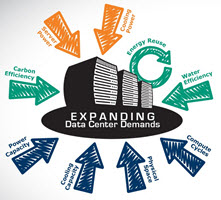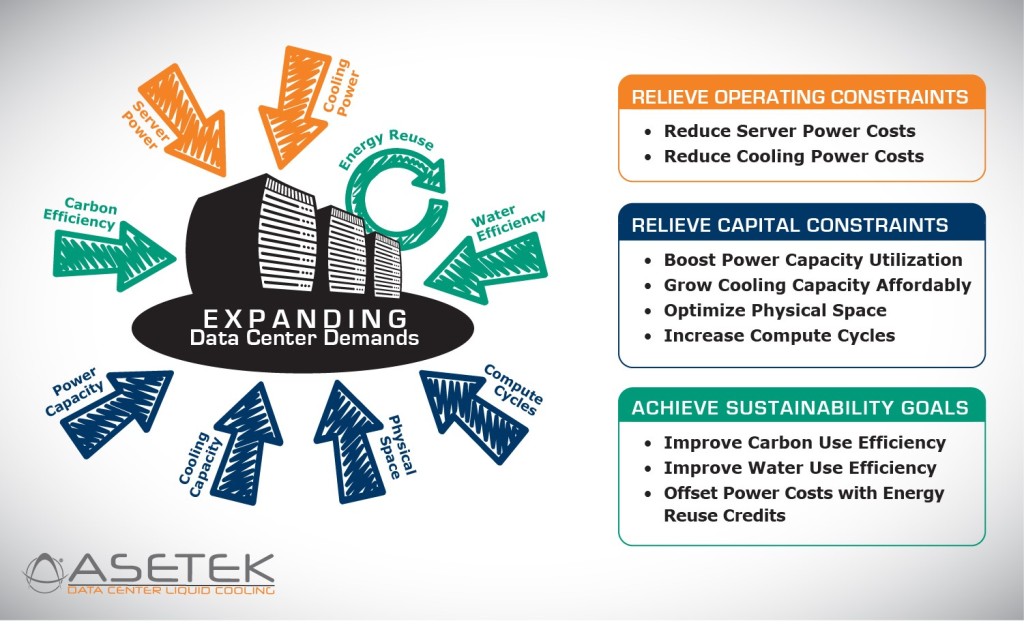Sponsored Post
With the growth of big data, cloud and high performance computing, demands on data centers around the world are expanding every year. Unfortunately, these demands are coming up against significant opposition in the form of operating constraints, capital constraints, and sustainability goals. In this article, we look at 8 of these constraints and how direct-to-chip liquid cooling is solving them. In future articles, we will go into more detail to explain the specifics of how this technology enables data centers to address these limitations.
- Server Power Costs
Fan power use from individual servers quickly adds up. Direct-to-chip liquid cooling replaces fan cooled air heat sinks with redundant liquid coolers inside each server. With the air heat sinks gone, fans spin slowly reducing the electricity needed to run servers.
- Cooling Power Costs
Air conditioners are inefficient and expensive to operate. Direct-to-chip liquid cooling replaces them with efficient dry or adiabatic coolers, saving substantially on the costs of cooling a data center.
- Power Capacity
Power capacity is shared between the power needed to operate servers and the power needed to run the infrastructure that supports them. Direct-to-chip liquid cooling cuts cooling and server power requirements allowing more compute within existing power capacity.
- Cooling Capacity
Direct-to-chip liquid cooling enables data centers to purchase lower cost dry coolers rather than more expensive chillers. For example, organizations like Mississippi State University are able to purchase more servers by minimizing the capital spent to cool the data center.
- Physical Space
Many data centers are being consolidated and need a more efficient use of the space they have. Liquid cooling enables higher density racks, allowing data centers to expand vertically (more compute power in each rack) rather than horizontally (buying more square footage). The U.S. Army’s Sparkman Center Data Center at Redstone Arsenal is using Asetek’s RackCDU liquid cooling technology to achieve a 2.5x server consolidation.
- Compute Cycles
Liquid cooling enables CPUs, GPUs and memory to operate at lower and more stable temperatures, allowing machines to run reliably at full compute power (or in some cases over-clocked) rather than being throttled down due to thermal constraints.
- Carbon Efficiency
Data centers use about 2% of total electricity in the United States. Direct-to-chip liquid cooling has the potential reduce that use by 25%, reducing the total carbon output of data centers.
- Water Efficiency
With climate change and growing populations around the world, efficient water use is become more and more important. Cooling with hot water extends the hours that data centers can free cool using dry cooling, saving the water otherwise used for evaporative cooling.
Direct-to-chip liquid cooling enables data center operators to meet the increasing demands of their user communities while meeting management demands to rein-in operating costs and capital expenditures. Stay tuned for our future articles that will go into more detail on how Asetek’s liquid cooling is addressing these constraints. If you’d like to see what Asetek’s RackCDU Direct-to-Chip liquid cooling can do for your data center, visit our Savings Calculator. There, you will be able to enter the specifications of your existing air cooled data center and get an idea of the benefits you can achieve. As always, feel free to contact us at questions at asetek.com to learn more.





